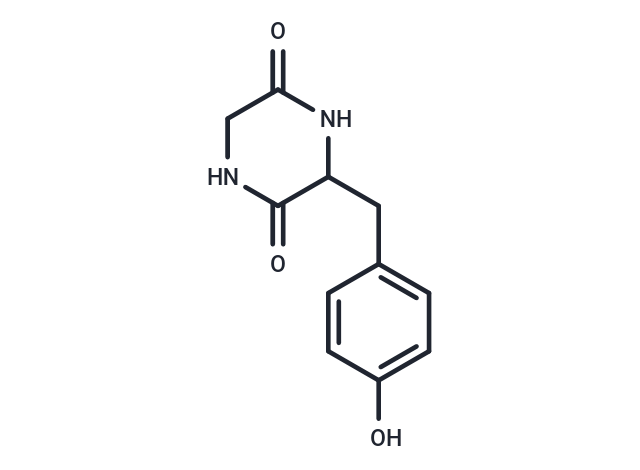Shopping Cart
- Remove All
 Your shopping cart is currently empty
Your shopping cart is currently empty

Cyclo(Tyr-Gly) is a natural product for research related to life sciences. The catalog number is TN6687 and the CAS number is 5625-49-0.

| Pack Size | Price | Availability | Quantity |
|---|---|---|---|
| 10 mg | $730 | Backorder | |
| 1 mL x 10 mM (in DMSO) | $500 | Backorder |
| Description | Cyclo(Tyr-Gly) is a natural product for research related to life sciences. The catalog number is TN6687 and the CAS number is 5625-49-0. |
| In vitro | METHODS AND RESULTS: Enrichment culture of soil samples with cyclo(Gly-Gly) and cyclo(Gly-l-Tyr) as a carbon and/or a nitrogen source resulted in the isolation of Arthrobacter sp. 1-3-1 and the coryneform rod bacterium, strain T-1-3-Y, as the bacteria which most highly assimilated cyclo(Gly-Gly) and cyclo(Gly-l-Tyr), respectively. Both bacteria had the enzyme activity hydrolyzing DKPs intracellularly in contrast to the extracellular cyclo(Gly-Gly) hydrolase reported previously. The cells of Arthrobacter sp. 1-3-1 degraded all diketopiperazines tested, including cyclo(Gly-Gly), cyclo(Gly-l-Ala), cyclo(Gly-l-Val), cyclo(Gly-l-Leu), cyclo(Gly-l-Ile), cyclo(Gly-l-Met), cyclo(Gly-l-Phe), cyclo(Gly-l-Tyr)(Cyclo(Tyr-Gly)), cyclo(l-Ala-l-Tyr), cyclo(l-Val-l-Tyr), cyclo(l-Leu-l-Tyr), cyclo(l-Tyr-l-Tyr), cyclo(l-Phe-l-Leu), cyclo(Gly-d-Ala), and cyclo(Gly-d-Leu). On the other hand, the degradation of d-amino acid-containing DKPs or cyclo(Gly-Gly) by the cells of the strain T-1-3-Y were detected hardly or not at all, respectively. CONCLUSIONS: From the result that DKP hydrolase in the strain T-1-3-Y had a higher stereospecificity than that in Arthrobacter sp. 1-3-1, the diversity of DKP hydrolases were found to be in nature. |
| Molecular Weight | 220.22 |
| Formula | C11H12N2O3 |
| Cas No. | 5625-49-0 |
| Relative Density. | 1.308g/cm3 |
| Storage | Powder: -20°C for 3 years | In solvent: -80°C for 1 year | Shipping with blue ice. |

Copyright © 2015-2025 TargetMol Chemicals Inc. All Rights Reserved.